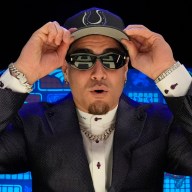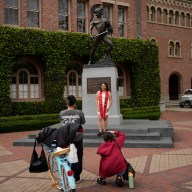 David Koechner returns to the role of alpha male sports reporter “Champ” Kind in “Anchorman 2.”
David Koechner returns to the role of alpha male sports reporter “Champ” Kind in “Anchorman 2.”
Credit: Getty Images
The actor David Koechner has a long history with improvisation and comedy troupes. He was a regular at ImprovOlympic and The Second City in Chicago before spending a year on “Saturday Night Live,” where he worked with Will Ferrell. His background made him an ideal person to be among the head quartet on Ferrell’s “Anchorman: The Legend of Ron Burgundy,” a modest hit in 2004 that has blossomed into a highly quoted cult sensation.
When the sequel inevitably came around, getting back into gear with Ferrell, Steve Carell and Paul Rudd wasn’t difficult. “This particular group, the rhythm never leaves,” Koechner say. “We’re so fortunate there’s a certain chemistry that’s just bountiful and works.”
Much more gracious and humble in person than his character, brash alpha male sports reporter “Champ” Kind, he defers to his bosses for hatching a creative environment. “The ensemble atmosphere is created by [director] Adam McKay and Will Ferrell. Their approach to the work is to be inviting and joyful. They pursue joy every moment of their lives.”
Like the first “Anchorman” — and the other McKay-Ferrell projects, like “Talladega Nights,” “Step Brothers” and “The Other Guys” — the sequel features a fair amount of improvisatory moments. It wasn’t a competition, though. “Everyone wants the scene to be as good as anything. If anybody has an idea, they offer it readily. No one’s trying to outdo anyone else.”
That said, it’s not like McKay and Ferrell write their script with gaps to be filled in by improv on the set. “If we didn’t change a syllable, it would still be amazing,” Koechner says of their scripts. “I remember when we were making the first ‘Anchorman.’ I was thinking, ‘How are we going to beat what’s already written? It’s brilliant.’” After shooting the scene as written three or four times, though, McKay would open it up to improv.
“Adam has a belief that more is better, and he’s right,” he says. “You want choices, especially now that you’re not shooting on film. Digital is disposable and cheap. You can just keep rolling. Give yourself different ideas, because when you’re in the editing bay, you want another laugh.”
The first “Anchorman” was also notable for having filmed so much that there came a separate, feature length film — called “Wake Up, Ron Burgundy: The Lost Movie” — made from material that wasn’t used in the theatrical film. Koechner says that may happen again. “This one we have three hours or more of movie. McKay has said there’s about 230 additional jokes that are great that we haven’t even used.” Koechner and cast even lobbied for McKay to “Kill Bill” the movie, which is to say cut it in half and release it separately.
Koechner also praises McKay and Ferrell’s ability to plot out narratives that take strange turns, which is further swelled by the improv. Says Koechner, “That’s what comedy is: it’s unexpected.”
















